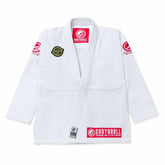Battle Ropes for BJJ: Build Strength, Endurance & How to Use Them
Introduction
Brazilian Jiu-Jitsu (BJJ) is not just about learning techniques. It is about developing a complete athletic profile. A good grappler needs raw strength, explosive power, muscular endurance, cardiovascular fitness, grip strength, and mental toughness. Battle ropes are one of the few training tools that can improve all of these attributes at once.
Unlike traditional weights, battle ropes challenge the entire body in a way that closely mimics the demands of BJJ. They combine strength, cardio, and coordination into one powerful workout. Hence, making them a perfect addition to your training arsenal.
This guide will show you why battle ropes are so effective for BJJ. Moreover, this will show how to use them correctly. And which exercises are best for building grappling-specific performance.
Why Battle Ropes Are Perfect for BJJ Athletes
1- Full-Body Engagement
Battle ropes demand coordination from head to toe. While your arms and shoulders drive the rope’s motion, your core, hips, and legs stabilize and generate force. This mirrors the way your body works in grappling i.e. multiple muscle groups working together in a chain.
2- Grip Strength and Endurance
One of the first things to fail during a hard roll is your grip. The constant movement of battle ropes keeps your forearms and hands engaged. Thus, building a crushing grip that can last through long sparring sessions or competition matches.
3- Cardiovascular Conditioning
BJJ is a mix of high-intensity bursts and sustained effort. Battle rope workouts raise your heart rate quickly and keep it elevated. Hence, building both aerobic capacity and anaerobic power, just like a fight.
4- Core Stability
Does not matter whether you are holding guard, passing, or defending a takedown. A strong core is non-negotiable. Battle ropes challenge your core in multiple planes of motion. as a result, improving stability, balance, and rotational power.
5- Explosive Power
Power is what allows you to bridge explosively, shoot for a takedown, or escape a bad position. Short, intense battle rope drills develop this ability without overloading your joints.
6- Mental Toughness
Sustaining intensity with battle ropes requires pushing past fatigue. It is exactly the mental skill you need in a tough roll or match.
Common Mistakes with Battle Ropes
Many athletes make errors that reduce the benefits of battle ropes or even risk injury.
Standing Too Close to the Anchor:
- This limits range of motion and reduces wave power.
- Fix: Step back far enough for the ropes to move freely.
Death Grip:
- Holding the ropes too tightly leads to early forearm fatigue.
- Fix: Keep a firm but relaxed grip.
Poor Posture:
- Rounded shoulders or a bent back steals power from your hips and core.
- Fix: Maintain an athletic stance i.e. chest up, knees slightly bent, core engaged.
Only Using Arms:
- Your whole body should drive the movement, not just your shoulders.
Fixing these mistakes will make your battle rope workouts safer and far more effective.
Types of Battle Rope Training for BJJ
Battle ropes can be used for different training goals. The key is to adjust your intensity, duration, and rest periods.
1- Endurance Training
Use moderate intensity for longer sets (30 seconds to several minutes) with short rests. This builds the capacity to keep working during long matches without burning out.
Example:
- 45 seconds alternating waves
- 15 seconds rest
- Repeat for 10–15 minutes
2- Strength & Strength Endurance
Use heavier ropes or higher intensity for shorter sets (30–60 seconds) with equal rest. This develops the ability to apply constant pressure and resist fatigue.
Example:
- 8 rounds of 30 seconds double slams
- 30 seconds rest between rounds
3- Explosive Power
Go all out for short bursts (5–20 seconds) with long rests. This is ideal for mimicking explosive moments like a sudden guard pass or takedown.
Example:
- 12 seconds side-to-side slams
- 48 seconds rest
- Repeat for 8–10 rounds
Best Battle Rope Exercises for BJJ
These exercises target the specific needs of grapplers i.e. strength, endurance, grip, and core stability.
1- Alternating Waves
Stand in an athletic stance and move each arm up and down alternately. Thus, creating continuous waves in the rope. This improves endurance, coordination, and grip.
2- Double Arm Slams
Lift both arms overhead and slam the ropes down hard. This develops full-body power and core engagement.
3- Side-to-Side Waves
Swing the ropes side to side, pivoting your hips. This builds rotational strength which is vital for guard passing and sweeps.
4- Plank Waves
Hold a plank position while creating small, quick waves with one or both arms. This challenges core stability and anti-rotational strength.
5- Grappler Throws
Simulate throwing an opponent by making large circles with the ropes. This improves shoulder endurance and rotational power.
6- Jump Squat Slams
Combine a squat jump with a rope slam for explosive lower body and upper body power.
7- Lateral Shuffle Waves
Move side to side while keeping the waves going. This develops footwork, coordination, and agility under fatigue.
Guide > Best Home Workouts for BJJ Strength and Conditioning
Sample Battle Rope Workout for BJJ
Here is a well-rounded session that trains endurance, strength, and explosiveness, all in one workout.
Warm-Up (5 minutes)
- Light alternating waves (1 min)
- Side-to-side waves (1 min)
- Dynamic stretching and mobility work (3 min)
Main Workout
- Alternating Waves: 30 sec on / 15 sec rest × 4
- Double Arm Slams: 20 sec on / 40 sec rest × 5
- Side-to-Side Waves: 30 sec on / 15 sec rest × 4
- Plank Waves: 20 sec each arm / 20 sec rest × 3
- Jump Squat Slams: 15 sec on / 45 sec rest × 4
Finisher
- 2 minutes continuous alternating waves at steady pace
- Cool Down (5 minutes)
- Light rope swings
- Stretching for shoulders, hips, and back
Sample Training Plan for BJJ Grapplers
| Session Goal | Format & Phases | Benefit for BJJ |
|---|---|---|
| Aerobic Base | 10–15 min alternating waves at 50% output | Builds sustained energy without taxing the CNS |
| Strength Endurance | 5×45 sec waves (60–70% output) with equal rest | Prepares you for mid-round resistance, control, and recovery |
| Power Integration | 6×15 sec V-slams or shuffle-waves at 90–100% effort | Simulates explosive entries, scrambles, takedown initiation |
| Core Stability | Plank waves + rainbow/smiles + figure 8s (30–45 sec sets) | Reinforces posture, balance, and rotational control |
| Grip Burnout | Finishers: endless triceps/biceps extensions (3–4 min) | Ensures grip and arm strength when it’s most taxed |
How to Fit Battle Ropes into BJJ Training
- Twice a Week: Enough to see results without interfering with mat time.
- Alternate Focus: One day for endurance, one day for explosive power.
- Use as a Finisher: After strength training or technical drilling to simulate late-match fatigue.
- Periodization: Reduce rope volume in competition week to keep energy for the mat.
Safety and Recovery Tips
- Always warm up before high-intensity rope work to protect your shoulders.
- Keep movements controlled because speed without form leads to injury.
- Hydrate and stretch after workouts to aid recovery.
- If you feel sharp pain (not fatigue), stop immediately and reassess form.
Final Thoughts
Battle ropes are one of the most versatile and BJJ-specific conditioning tools available. They build the strength to control opponents, the endurance to outlast them, and the power to explode at the right moment.
By mixing endurance, strength, and power drills into your rope training, you will see a direct improvement in your grappling performance. Combine this with proper BJJ practice, and you will have both the skill and the conditioning to dominate on the mats.







